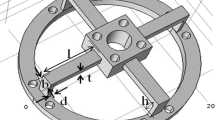Abstract
The paper provides a new technique based on a least-squares approach for the accurate estimation of a force platform calibration matrix using simple manual procedures, when the direction of the applied loads cannot be perfectly aligned with the axes of the platform. This new procedure can be applied to all force platforms and allows the combined application of vertical and horizontal forces, both static and time-varying. The robust calibration method includes the angular errors in the least-squares parameter vector, thus reducing the bias in the estimated calibration matrix parameters. The performance of the robust method was compared with the conventional one, using a numerical simulation approach starting from a known calibration matrix. With the conventional approach, in noiseless conditions, the maximum error due to load misalignment (SD=3°) was 6% for the direct terms and over 10% for the cross-talk terms. With the robust method, these errors reduced to zero and were always below 0.4%, even when realistic noise was superimposed on the measures. With perfectly aligned loads and realistic output noise, the confidence intervals of the calibration matrix parameters were very similar for the two methods, demonstrating that the increased number of parameters did not affect the reliability of the estimate.
Similar content being viewed by others
References
Berme, N. (1990): ‘Load transducers’, inBerme, N., andCappozzo, A. (Eds): ‘Biomechanics of human movement, applications in rehabilitation, sports and ergonomics’ (Bertec, Washington, 1990), pp. 140–149
Bobbert, M. F., andSchamhardt, H. C. (1990): ‘Accuracy of determining the point of force application with piezoelectric force plates’,J. Biomech.,23, pp. 705–710
Browne, J., andO'Hare, N. (2000): ‘A quality control procedure for force platform’,Physiol. Meas.,21, pp. 515–524
CAMARC II (1994): ‘Standards for instrumentation and specifications’, Technical Report, AIM Project A2002
Cappello, A., La Palombara, P. F., andLeardini, A. (1996): ‘Optimization and smoothing techniques in movement analysis’,Int. J. Biomed. Comput.,41, pp. 137–151
Cappozzo, A. (1984): ‘Gait analysis methodology’,Hum. Mov. Sci.,2, pp. 27–50
Chockalingam, N., Giakas, G., andIossifidou, A. (2002): ‘Do strain gauge force platforms need in situ correction?’,Gait Posture,16, pp. 233–237
Draper, N., andSmith, H. (1966): ‘Applied regression analysis’ (John Wiley & Sons, Inc., 1966)
Dubois, M. (1981): ‘Six-component strain-gauge balances for large wind tunnels’,Proc. Soc. Exp. Stress Anal.,38, pp. 401–407
Fairburn, P. S., Palmer, R., Whybrow, J., Fielden, S., andJones, S. (2000): ‘A prototype system for testing force platform dynamic performance’,Gait Posture,12, pp. 25–33
Fleming, H. E., Hall, M. G., Dolan, M. J., andPaul, J. P. (1997): ‘Quality framework for force plate testing’,Proc. Inst. Mech. Eng. (H),211, pp. 213–219
Gill, H. S., andO'Connor, J. J. (1997): ‘A new testing rig for force platform calibration and accuracy tests’,Gait Posture,5, pp. 228–232
Gola, M. M. (1980): ‘A calibration procedure of a new platform’,Acta Orthop. Belg.,46, pp. 522–533
Hall, M. G., Fleming, H. E., Dolan, M. J., Millbank, S. F. D., andPaul, J. P. (1996): ‘Static in situ calibration of force plates’,J. Biomech.,29, pp. 659–665
Lenzi, D., Cappello, A., andChiari, L. (2003): ‘Influence of body segment parameters and modeling assumptions on the estimate of center of mass trajectory’,J. Biomech.,36, pp. 1335–1341
Mita, K., Akataki, K., Itoh, K., Nogami, H., Katoh, R., Ninomi, S., Watakabe, M., andSuzuki, N. (1993): ‘An investigation of the accuracy in measuring the body centre of pressure in a standing posture with a force plate’,Front. Med. Biol. Eng.,5, pp. 201–213
Schmiedmayer, H. B., andKastner, J. (1999): ‘Parameters influencing the accuracy of the point of force application determined with piezoelectric force plates’,J. Biomech.,32, pp. 1237–1242
Schmiedmayer, H. B., andKastner, J. (2000): ‘Enhancements in the accuracy of the center of pressure (COP) determined with piezoelectric force plates are dependent on the load distribution’,ASME J. Biomech. Eng.,122, pp. 523–527
Winter, D. A. (1991): ‘Biomechanics and motor control of human gait, 2nd edn’ (University of Waterloo Press, Waterloo, 1991)
Author information
Authors and Affiliations
Corresponding author
Rights and permissions
About this article
Cite this article
Cappello, A., Lenzi, D. & Chiari, L. Periodicalin-situ re-calibration of force platforms: A new method for the robust estimation of the calibration matrix. Med. Biol. Eng. Comput. 42, 350–355 (2004). https://doi.org/10.1007/BF02344711
Received:
Accepted:
Issue Date:
DOI: https://doi.org/10.1007/BF02344711




